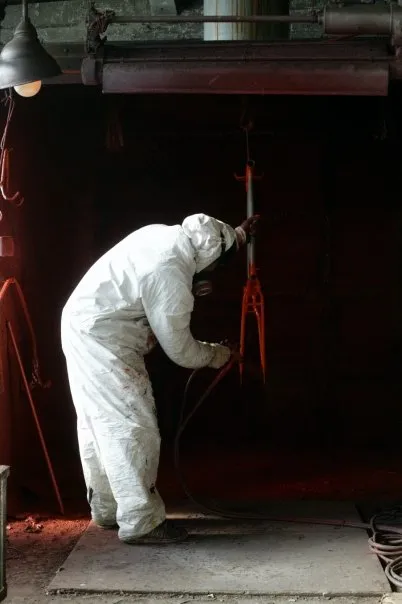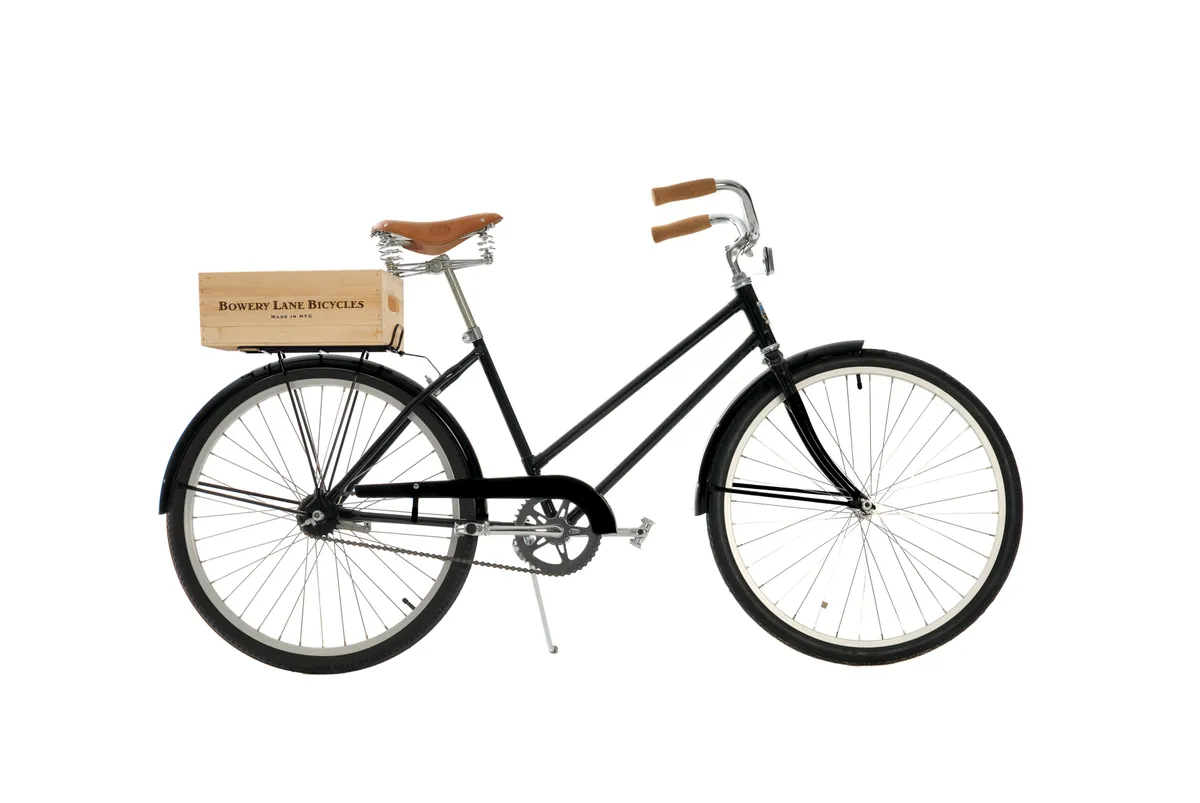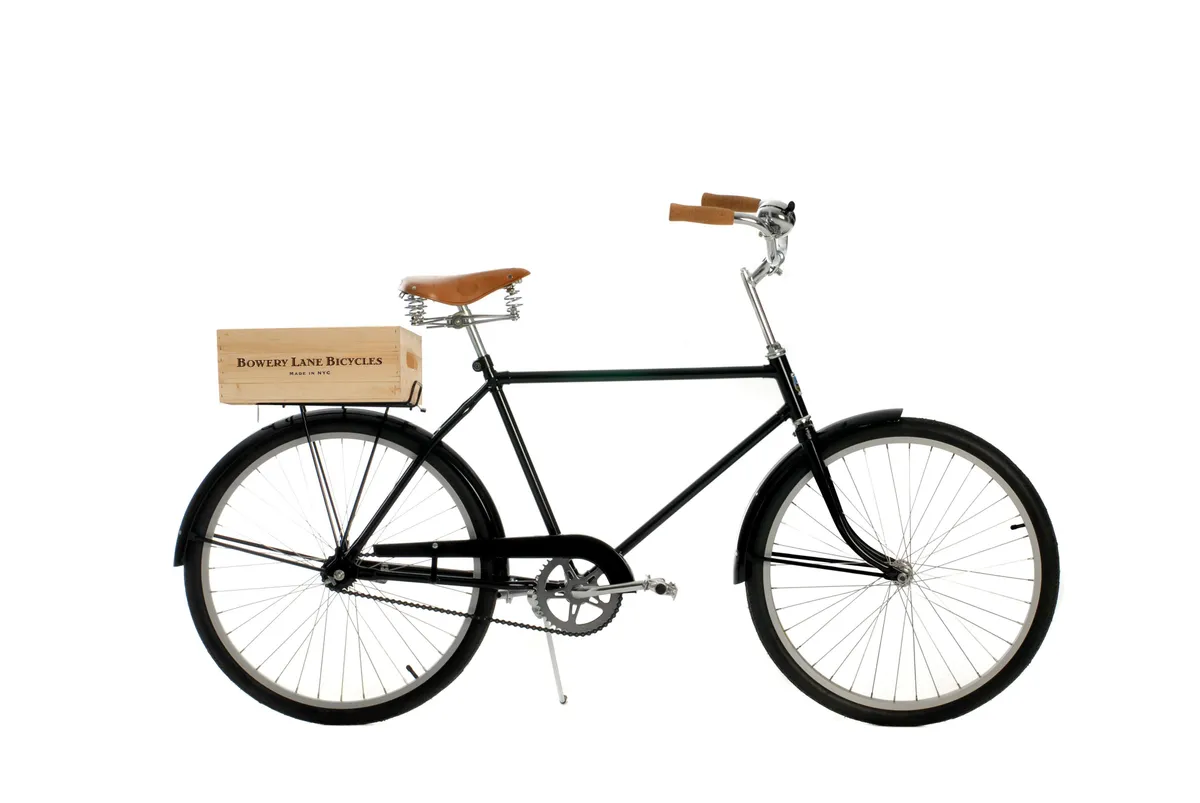Bowery Lane Bicycles was founded by Sean Naughton and Patrick Benard in 2008. The company makes sub US$600 Dutch-styled hauling bikes for urban use in its New York City factory with American steel using solar energy.
BikeRadar caught up with the Bowery duo to find out more about the company, its mission and vision for American-made bicycles.
BikeRadar: How did Bowery Lane Bicycles evolve?
Sean Naughton: The original idea for the company came from Patrick’s trips to Europe and specifically Amsterdam. I haven’t been, but I’ve always had friends come back and rave about how great a city it is and how EVERYONE gets around by way of bicycle. The idea was to help create that type of culture here in New York, to help it along by giving people a different option of bike than what’s currently out there. Bowery Lane Bicycles are designed to be good looking, inexpensive bikes that can be used as a mode of transport and transportation. There is a movement happening here and we want to be part of it. Let’s help get people out of their cars and above ground.
As for the design, one of our thoughts was that good vintage bikes are becoming harder and harder to come by and the bikes of today aren’t going to be good vintage bikes in the future. The quality is really poor due to plastic parts, etc. We wanted to make a timeless classic bike. One that is fashionable. One that will last. The Broncks raw bike, in particular, came from us going to the factory and seeing the beauty of raw, unpainted, unpolished steel, the beauty of the it’s imperfection.

The unpainted and clearcoated Bowery Broncks model
The raw steel is also cool because it can have any number of color characteristics (blues and greens) in different light and the exposed brass of the joints is striking... a fantastic contrast.
Another interesting story behind the design is the head badge. I was stuck in one of the old courthouses for jury duty last year and had a ton of free time on my hands waiting to be picked. They had a bunch of fantastic old wall murals picturing life and maps of the colony of New Amsterdam: golden sun beams intersecting the green of the island’s terrain, the wood houses, and the windmills. I was in awe. I snuck a few pictures and incorporated some of the aspects into the badge.
Tell us a bit about your backgrounds and what motivates you with Bowery.
Sean Naughton: I was an anthropology major in college and an athlete. I fell into the fashion/apparel business at the mall and made a career of it. I worked my way up the ladder for companies such as Guess, Bloomingdales, Ralph Lauren and Miss Sixty. Me and my good friend Tim Ellis left the corporate world and started an independent sales showroom five years ago where we work with up and coming designers/brands. We sell and develop brands to/for everyone from Urban Outfitters to Barneys.
I’m a big fan of US history, specifically local history. I grew up in a great old Hudson River town called Ossining, home of the infamous Sing Sing prison. You could hear lock down from my house if the wind was blowing up from the river. There was so much historical stimulation around, if you were open to seeing it.
I have lived in the East Village for 14 years and love the same type of history I find here. You have to dig for it, but that’s the fun part. I love stories of old New York and its roots in the Old Dutch colony of New Amsterdam. I was really inspired by Russell Shorto’s book 'Island at the Center of the World' and how it has influenced New York City as we know it today. It was a great liberal, culturally diverse society lodged in between the puritans and the pilgrims, who weren’t very tolerant.
I think freedom of thought and movement goes hand in hand. What’s more freeing then riding a bike to work, to home, to go out and meet friends for a pint? The bicycle is without question the best way to get around NYC and the best way to view the city sites along the way.
Patrick Benard: I've always been an avid cyclist. I have cycled Maine to Montreal, most of Southern France and Northern Italy as well as three quarters of the coast of Australia. I have seen how cycling can improve the quality of life of cities in Europe but also in places like Havana and would love to see certain parts of America enjoy the same freedom from the automobile.
Tell us a bit about Bowery's manufacturing process.
Sean Naughton: We're using a factory that has been making bikes since the 1890s (Worksman Cycles ed.). They make industrial bikes, delivery bikes, hot dog carts, etc. so the quality we need for tough city streets is there.

I guess the most special thing is that we can do it locally, by hand and still sell them for under US$600. I don’t think you can find any other bike company out there boasting the same thing.
Patrick Benard: The process is very old school. The frames are hand welded and hand painted. These bikes are hand touched a lot. It’s fair to say that what's unique is that our manufacturing is without a doubt the last great American manufactured bike for the masses. There are many high-end boutique manufacturers, but this kind of affordable mass appeal is the last of its kind.
How did the development process go? Any highlights?
Sean Naughton: Two moments for me; when we received the first prototypes and rode them around for a few days. The reactions from complete strangers was amazing; the looks, the comments when you stopped at a light. It was all great.
Another was when I rode a bike to the playground on 12th and Ave B. I was there playing with my son and I brought the bike into the playground. Twenty minutes into it and I turned around and there was a crowd of parents around the bike. I thought I was in trouble for bringing it in, but they all loved it. It was cool.

The Bowery Brueklyn model
Patrick Benard: The proudest moment for me was of selling one of the bikes to a girl from the upper West side. She came over and bought a bike I happened to have left from the Capsule trade show. She rode it and just beamed with girlish joy. She took it home and emailed me a day latter telling me how much she loved it and how much praise she was hearing on the street. It made me very happy.
What's your long-term vision for Bowery Lane Bicycles?
Sean Naughton: Our hope is that we will have several brands like Bowery with other qualities. Bowery will continue to be the early century retro bike but other lines may be inspired by other eras/styles.
What new designs are in the pipeline?
Sean Naughton: Spring will see a launch of a new model or two. I have a good idea what they will be. We also have plans for a great commuter jacket. It has some great aspects of a technical cycling jacket but you would be very comfortable wearing it to work or out with friends.
Patrick Benard: Re-tooling a manufacturing process is expensive, so many times we work with the manufacturer on what is available and incorporate it into the design. We will have new models next year, new gears and colors on the existing designs in the shorter term.
Which bike companies have influenced your approach to Bowery Lane?
Sean Naughton: The beauty of some of the Old Italian bikes and the utility of the Dutch companies.
Patrick Benard: I like Fietsfabrik from Holland and Workbike. In the US, there is only Cannondale that has the right priced bikes. There are other amazing US bikes as well, but most of my faves are US$2,000 which isn’t very affordable. I own six or seven bikes right now.
What do you think of the growing number of adults riding bikes to work?
Sean Naughton: I think it’s amazing. I would love to see the numbers double in the next few years. Hate to say it, but it’s going to have to come from politicians that control people’s access to safe roads. I was just in Los Angeles and I can’t imagine riding a bike on the city streets there. It’s a shame.
Patrick Benard: I think it’s very encouraging for cities like New York especially. On weekends when major avenues are closed to cars, the entire city seems to benefit from cleaner air and happier citizens.

